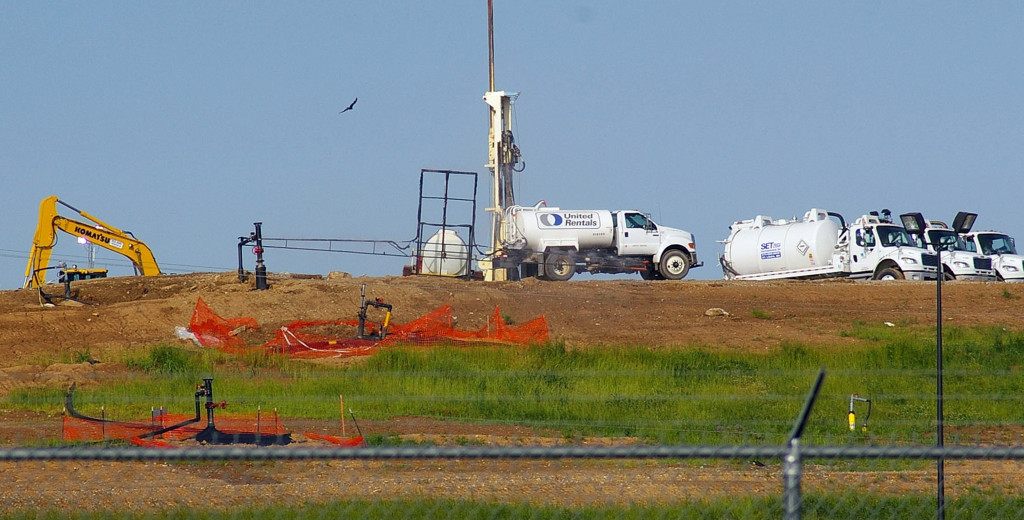Underground fire 300 meters from nuclear waste causes St. Louis to hatch contingency plan

FILE – In this May 22, 2013, file photo crews works to contain odors from a slow-burning underground fire smoldering near a cache of nuclear waste at the Bridgeton Landfill in Bridgeton, Mo. Authorities have quietly adopted an emergency plan in case the smoldering embers ever reach the waste, a potentially “catastrophic event” that could release radioactive fallout in a plume of smoke over a densely populated area of suburban St. Louis. (AP Photo/St. Louis Post-Dispatch, Roland Klose, File) MANDADORY CREDIT; EDWARDSVILLE INTELLIGENCER OUT; THE ALTON TELEGRAPH OUT
AP
ST. LOUIS – Beneath the surface of a St. Louis-area landfill lurk two things that should never meet: a slow-burning fire and a cache of Cold War-era nuclear waste, separated by just 300 meters.
Government officials have quietly adopted an emergency plan in case the smoldering embers ever reach the waste, a potentially “catastrophic event” that could send up a plume of radioactive smoke over a densely populated area near the city’s main airport.
Although the fire at Bridgeton Landfill has been burning since at least 2010, the plan for a worst-case scenario was developed only a year ago and never publicized until this week, when St. Louis radio station KMOX first obtained a copy.
County Executive Steve Stenger cautioned that the plan “is not an indication of any imminent danger.”
“It is county government’s responsibility to protect the health, safety and well-being of all St. Louis County residents,” he said in a statement.
Landfill operator Republic Services also downplayed any risk. Interceptor wells — underground structures that capture below-surface gases — and other safeguards are in place to keep the fire and the nuclear waste separate.
“County officials and emergency managers have an obligation to plan for various scenarios, even very remote ones,” landfill spokesman Russ Knocke said in a statement, calling the landfill “safe and intensively monitored.”
The cause of the fire is unknown. For years, the most immediate concern has been an odor created by the smoldering. Republic Services is spending millions of dollars to ease or eliminate the smell by removing concrete pipes that allowed the odor to escape and installing plastic caps over parts of the landfill.
Directly next to Bridgeton Landfill is West Lake Landfill, also owned by Republic Services. The West Lake facility was contaminated with radioactive waste from uranium processing by a St. Louis company known as Mallinckrodt Chemical. The waste was illegally dumped in 1973 and includes material that dates back to the Manhattan Project, which created the first atomic bomb in the 1940s.
The Environmental Protection Agency is still deciding how to clean up the waste. The landfill was designated a Superfund site in 1990.
The proximity of the two environmental hazards is what worries residents and environmentalists. At the closest point, they are 1,000 to 1,200 feet apart (305 to 365 meters).
If the underground fire reaches the waste, “there is a potential for radioactive fallout to be released in the smoke plume and spread throughout the region,” according to the disaster plan.
The plan calls for evacuations and development of emergency shelters, both in St. Louis County and neighboring St. Charles County. Private and volunteer groups, and perhaps the federal government, would be called upon to help, depending on the severity of the emergency.
No reports of illness have been linked to the nuclear waste. But the smell caused by the underground burning is often so foul that Missouri Attorney General Chris Koster sued Republic Services in 2013, alleging negligent management and violation of state environmental laws. The case is scheduled to go to trial in March.
Last month, Koster said he was troubled by new reports about the site. One found radiological contamination in trees outside the landfill’s perimeter. Another showed evidence that the fire has moved past two rows of interceptor wells and closer to the nuclear waste.
Koster said the reports were evidence that Republic Services “does not have this site under control.” Republic Services responded by accusing the state of intentionally exacerbating “public angst and confusion.”
Ed Smith of the Missouri Coalition for the Environment said he would like to see the county become even more involved “to ensure that businesses, schools, hospitals and individuals know how to respond in a possible disaster at the landfill, just like preparing for an earthquake or tornado.”
Underground smoldering is not unheard of, especially in abandoned coal mines. Common causes include lightning strikes, forest fires and illegal burning of waste.
At least 98 underground mine fires in nine states were burning in 2013, according to the Office of Surface Mining Reclamation and Enforcement.
Few underground fires can match one in Centralia, Pennsylvania. In 1962, a huge pile of trash in the town dump, near a coal mine, was set on fire, and it has burned beneath the town for more than half a century. Only a few people remain in a community that once had 1,000 residents.
http://www.japantimes.co.jp/news/2015/10/08/world/st-louis-girds-catastrophic-event-underground-fire-burning-since-10-get-near-cold-war-nuke-waste-cache/#.VhZsBBNVhBc
